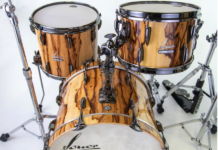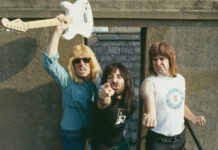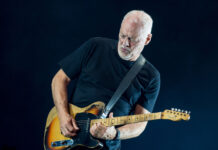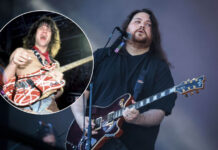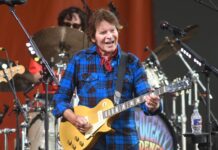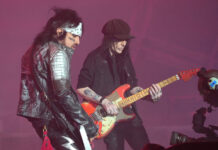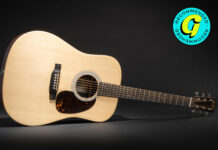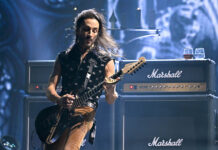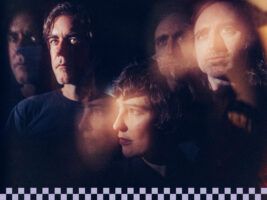
Oliver Ackermann on Death By Audio, A Place To Bury Strangers and turning an LP into a synth
Neither of Oliver Ackermann’s two main projects should, if we’re being sensible, be experienced without hearing protection. He’s perhaps best known in guitar-nerd circles as the founder of New York pedal brand Death By Audio, makers of brilliant, loud and noisy effects like the Fuzz War, the Apocalypse, and the Absolute Destruction.
But Ackermann describes himself as a musician first – pedal-making came so he could achieve the out-there sounds he wanted, and A Place To Bury Strangers is the best place to hear them. The band, now a trio formed of Ackermann, John Fedowitz on bass, and Sandra Fedowitz on drums, is the recorded equivalent of a Death By Audio fuzz – loud, untamed, driving noise-rock that thrashes and sparks like a downed electrical cable on a wet highway. Their live shows are filled with as much sonic destruction as they are very literal guitar destruction.
READ MORE: Heriot on doing heavy their own way: “This is a fresh take on the genre that we all love”
The two projects are linked, of course – the wonky guitar sounds that underpin the band’s post-punk/noise-rock mix are the result of a board full of Death By Audio pedals. DIY Death By Audio synths are taken on the road to provide crazy drones, and the DBA pedal workshop doubles as a rehearsal and guitar-storage space. And A Place To Bury Strangers’ new album Synthesizer is appropriately titled, too – the LP cover doubles as a circuit board for, well, an actual Death By Audio-designed synthesizer.
“It just seemed like it was the right time,” Ackermann explains. “I’d been building a lot of these different synths, and we were going to be using them on the record – so we decided to make the album cover a circuit board. I just think circuit boards look so cool, all the metal and crazy silkscreens and stuff going on. So why not make this album cover something that you can build and play and create some crazy noise?”
The form-factor of a big, flat synth circuit board draws on some custom synths Ackermann built into flight-cases for easy transport between shows. “All the time you’re thinking about how these things can be constructed,” he says. “You always have to think, how’s this going to work in any sort of enclosure? Whether it’s a guitar or anything. And that’s just sort of the natural progression of where you’re going to put that stuff.
“Those synthesizers that we built for playing shows – they started as the simplest, single-op amp oscillators. But that just sounds so massive on a stage: a sine wave blasting out of a giant Ampeg SVT. So you take that from there – things get more complicated, you start throwing reverb and stuff all on it, then you have something that’s really fun. A lot of time, guitar players don’t really know that that’s something that they can be messing with. They see a keyboard, they’re like ‘I don’t know, this is too much for me’. But if you dumb it down in some kind of way, then you get to, like, the pure, awesome essence of emotion and expressiveness.”
L-R: Sandra Fedowitz, John Fedowitz and Oliver Ackermann of A Place To Bury Strangers. Image: Ebru Yildiz
A Human Element
That expressive, tactile approach hugely informs the aesthetic of A Place To Bury Strangers, too. “I realised this while I was sending away the stems for Synthesizer,” Oliver says. “Listening back to everything that’s going on, you realise what you’ve recorded is so imperfect all over – and the feeling of that stuff is almost all that’s left in music in some ways – the mess ups, the mistakes, the real feeling of someone actually pushed into doing this stuff.”
“There’s all sorts of songs I recorded – there’s ones that were done totally in the box and sound perfect, everything was a midi-programmed… and none of those songs made it on the record. It’s that kind of feeling where things are kind of messed up, and how to control that – that’s what I’m drawn to, at least.”
And for Synthesizer those imperfect, in-the-room moments were allowed to breathe, with minimal overdubbing on a lot of the tracks reflecting how they were born. “A lot of songs were just written by us in the room, and a few of the tracks on the record are pretty much just one take of us – with maybe a kind of Peel Sessions attitude where you can each record just one thing on top of it. We did multiple versions of a couple of these songs, and the ones where we’d painstakingly work over many layers and tracks – that’d just suck the energy out of it.”
For Ackermann, the central influences to A Place To Bury Strangers are bands where there’s “mystery” to the guitar sounds, some aspect of unpredictable strangeness that inevitably comes back to the effects-heavy sounds of My Bloody Valentine, The Jesus And The Mary Chain, Ministry and The Cure. He compares it to the difference between looking up a tab for a part and actually hearing it – and understanding the amount of layers and noise going on is what’s truly bringing it all together.
It’s an approach that the band brings to live shows, too. “We’ve started this thing where we’ll get out into the crowd and improvise – and there, you sort of have to dumb things down, but add other elements on top of it to make it interesting again. And then those things can become really emotional and powerful – like, where can you go on top of just a drone? You’ll start to create notes that are conflicting with these other notes, and it’s more than just this basic songwriting approach – it’s almost like there’s a feeling, or a change or shift. You don’t quite know what it is, and that’s the exciting part.”
Appetite for destruction
Talk of A Place To Bury Strangers’ live shows inevitably brings us to Ackermann’s habit of smashing seven shades of shit out of his guitars – it’s not uncommon to see him chuck a plugged-in Jaguar 20 feet in the air before picking up the pieces and holding the strings at tension so more noise can be made. If there was ever a band that could be sponsored by a brand of wood-glue, this would be it.
His reasoning (aside from it making cool sounds) is a surprisingly zen one – it becomes a way of controlling the inevitable chaos. “You know, you’re starting out, you don’t have much of anything, you’re on tour, and the one bass amp that you have blows up. Or the venue only has some teeny amp. Or the kick drum breaks. All of these things that are hindrances to your performances – you start to realise that you don’t even really need all of that stuff, that they aren’t really important,” Ackermann says.
“I’ve played so many shows where everything’s gone wrong. You know, you’re trying to play some really intricate lead part, and your D string is broken, and it’s like: how do you readapt to that situation? Breaking all of these guitars, you become connected with the chaos that’s happening. How do you play a guitar that isn’t intonated? Or, how do you play a guitar where the strings are really high off the fretboard? Or how do you make a noise with a guitar that’s snapped in half?
“It leads to these moments of struggle, and some adverse thing happening that you have to overcome, you have to work with what you have – and you feel like, you know what, we’re going to make this stuff awesome even if all the odds are against us. And there’s a calm where you become okay with whatever shitty situation is thrown at you. You can embrace it. We’ve played shows where all of the guitar amps blew up – so, I’d walk to the sound desk and go, give me a DI or something – there’s all this crazy noise and shit going on. But you get back on stage, you pick up the monitors, face them towards the audience and play a crazy show with what you’ve got.”
Image: Ebru Yildiz
Death By Audio
This approach is, of course, closely related to the DIY beginnings of Death By Audio. “Originally, I just wanted to create sounds that nobody else had ever heard before. That I had never heard before,” Ackermann explains. “You start doing this stuff, you’re just failing and failing and failing constantly, you’re ruining lots of things – at a time when there wasn’t any real guidance. I was reading electronics books, and I didn’t understand them. Nobody showed me how to solder. I spent years teaching myself how to and now, I could show someone in two minutes.
“But having gone through those different things, having deconstructed so many pedals and tried to create sounds and build amplifiers and build patch cables and understand all that stuff, you start to see what can go wrong, and debug that stuff quickly. So it’s easier for me to see what things kind of create these sounds, what’s an interesting opportunity for how to twist sounds and so on. And that goes hand in hand with the physicality of these things.”
It’s an approach that intuitively makes more sense with analogue gear – you can easily picture a mad-scientist-like Ackermann experimenting with components on a bench to create wild fuzz creation – but, more recently years, Death By Audio has embraced digital creations with equal fervour.
“I would often travel around with a rack unit to do these great expansive stereo reverbs. I love stereo sound. So it’d be like, carrying four or five amplifiers or something, all going through different reverbs and all this crazy programmed stuff – that was always my sound. So I would always be buying as many of these different units as possible, trying them out and seeing what else you could do with this stuff, all these MIDI program changes and stuff like that.
Synthesizer album cover
“So when it seemed like there was the opportunity, for Death By Audio to do something with a more affordable processor – the Spin processor, designed by the same people who do, like the Alesis rack units – it was like, I want to figure this out and learn how to do this, because I’ve got ideas for reverb that I don’t know if anybody’s ever done before. So I just got to trying to teach myself programming, and trying and trying and trying.
“That’s the best motivation, I feel like, to do anything – to desperately want the outcome. If you desperately want to hear some awesome song, or you desperately want your distortion to be more face-melting than anything anyone’s ever heard, or you desperately want to create some sound coming from eight speakers out of a piano or something – whatever it your dream is, that’ll be motivation to kind of make that stuff happen.”
Of course, a lot of digital gear can tend towards sonic cleanliness, which isn’t really Death By Audio’s aesthetic. But for Ackermann, it’s all just part of a toolkit. “With digital, you can make things that are super sterile, or you can make things that sound super wonky, but that’s something that’s just at the core of designing any effects or recording any music. ‘What are you going to do with it? What’s your take on it?’
“You have to make those decisions as a designer. When you design a fuzz pedal even, it’s like, we could have this knob that just makes it gargle or makes it sputter or whatever, but is it useful as a tool? Is it going to make someone want to push their music further? Is it useful for someone who wants it to be easily controlled on a stage? Or dramatically controlled on a stage? And is it going to enable someone to make their dreams and visions come true?”
Synthesizer is out now as both a regular LP and a full synth kit.
The post Oliver Ackermann on Death By Audio, A Place To Bury Strangers and turning an LP into a synth appeared first on Guitar.com | All Things Guitar.
Source: www.guitar-bass.net

